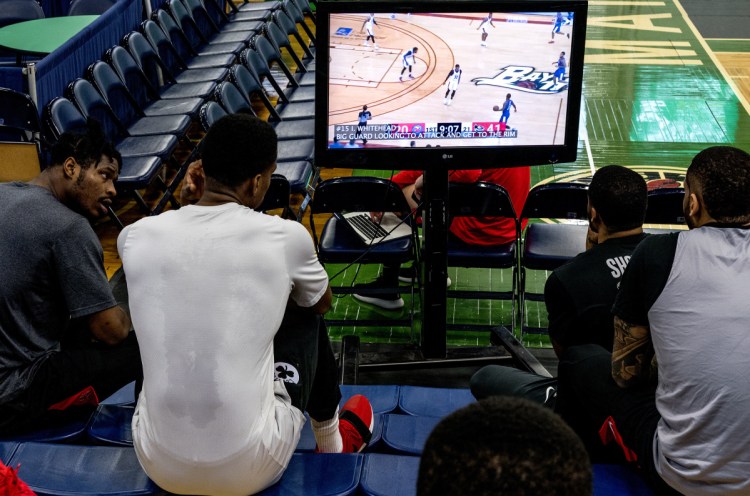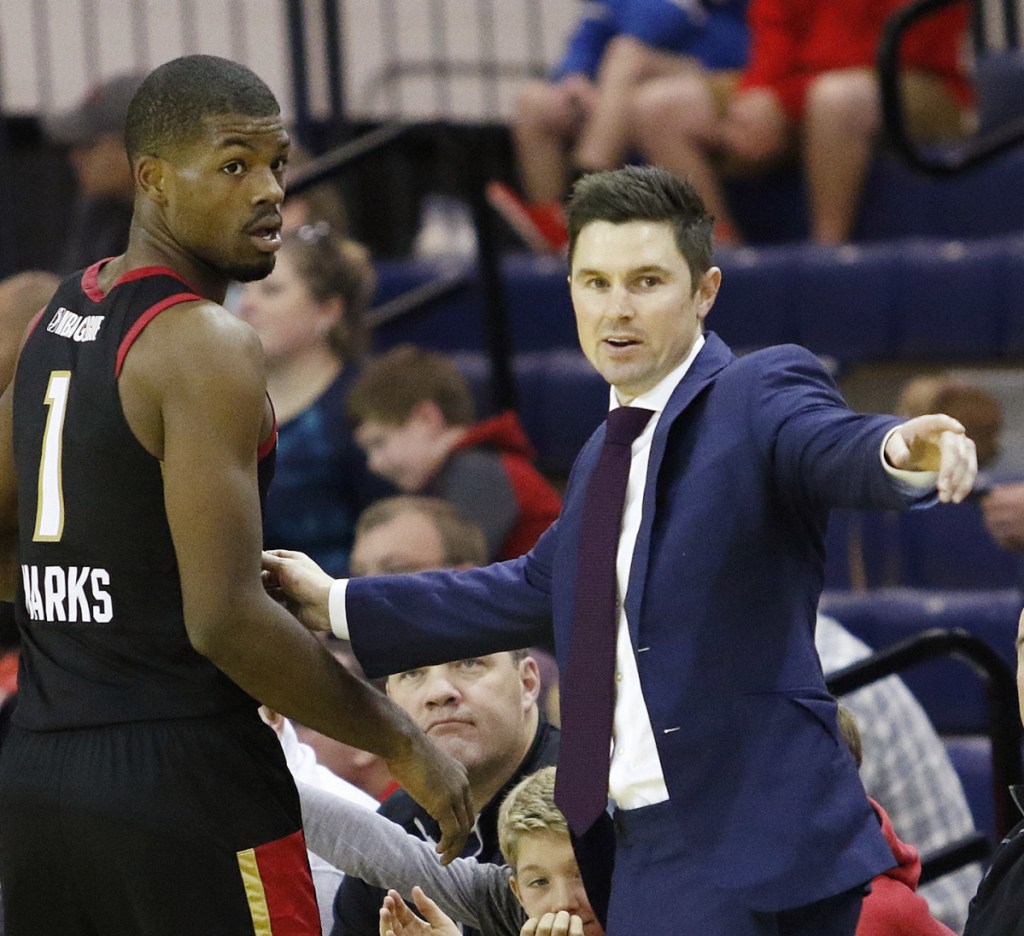It may look like a run-of-the-mill MacBook Pro, but in the capable hands of Josh Longstaff, his laptop computer becomes something else.
“The Truth Box is what I like to call it,” said Longstaff, the 35-year-old Portland native and head coach of the Erie BayHawks. “I can tell a player, ‘It’s not me just telling you this. See, it’s right there.’ ”
Longstaff and Brandon Bailey of the Maine Red Claws – both rookie head coaches in the G League – got their pro basketball starts as grunts who toiled endlessly over laptops, editing raw video into a format useful to coaches and players. Now they’re passing on their technological expertise to their own assistants, and helping players develop into better pros.
Bailey, 32, landed an unpaid internship with the Boston Celtics under Doc Rivers in 2011. He rose through their video department under Brad Stevens before taking over the Red Claws last summer.
Longstaff, a former walk-on at Bryant University, was an assistant at Portland High and head coach at Gorham High before joining the Oklahoma City Thunder’s video department in 2010. A former Bryant assistant coach worked for the Thunder and had helped arrange a visit a year and a half earlier; Longstaff kept in touch with people he met, and his interest and persistence paid off.
Current NBA head coaches Erik Spoelstra of Miami, Frank Vogel of Orlando and Mike Budenholzer of Atlanta (Erie’s parent club) got their foot in the pro basketball door by paying their dues in video.
“My first year, a lot of the stuff was way over my head,” Bailey said of his seven-month Celtics internship. “You’re dealing with Coach Rivers, Paul Pierce, Kevin Garnett, Ray Allen, (Rajon) Rondo. You’re just trying not to get fired. You’re doing everything you can to just not mess up.”
Bailey typically arrived at work before 5 a.m. to download games from the previous night, print out all stats and reports, and “staple them a certain way for our defensive coordinator and the rest of our coaching staff,” he said. Each game would be reduced to 35-40 minutes of clips, grouped by offensive or defensive possessions.
EXTENSIVE PREPARATION
During Red Claws home games, assistant coach Evan Bradds sits behind the scorers’ table with a live feed to his laptop. He breaks the action into individual clips, offense and defense, as the game progresses. Within 15 minutes of the final buzzer, Bradds hands a hard drive to an opponent’s assistant coach so the edited game can be downloaded to their laptops.
“When we go places,” Bradds said, “they do the same thing.”
Each assistant coach is responsible for preparing a scouting report on an upcoming opponent. On a recent Monday, that job fell to Allen Harris, who made a three-minute presentation on the next night’s opponent, the Long Island Nets.
“We’ll go over the personnel so the players can sleep on it,” said Harris, after showing a montage of three to four clips per opposing player, highlighting strengths and weaknesses, pointing out tendencies and how to defend him.
All clips came from Long Island’s five previous games, which Harris had studied, edited and boiled down into what he felt were essential parts. Originally from Boston, Harris played at St. Anselm College in New Hampshire and at Virginia State before becoming a coach. This is his fourth year in coaching and first in pro basketball.
“I’ve definitely worked with film before, but not as extensive as I have here,” Harris said. “Brandon came up in the film room, so film is big with him.”
On Bailey’s desktop sit folders containing clips of, for example, every late-game, post-timeout play drawn up by Stevens, the Celtics’ coach known for his strategical acumen. Another folder contains clips of every other late-game ATO (after timeout) used in the NBA this season. Bailey has drawn his favorites on a large whiteboard mounted behind his desk in the bowels of the Portland Expo.
Just don’t ask him for home movies of his kids.
“People think we’re really good at technology,” Bailey said. “We’re not. We’re really good at cutting film, basketball-wise. That’s it. We can’t do iMovie.”
‘IT’S LIKE A SCIENCE NOW’
As with anyone reliant on technology, Bailey has endured his share of glitches. The worst, however, came about because of human error. During a Celtics trip to Atlanta, Stevens requested an edited package from Bailey, then asked for a revision.
“As I was putting it together, I wasn’t thinking about it a whole lot,” Bailey said. “But I was like, ‘I’m not really sure where he’s going with this edit. This is weird.’
“Then I’m sitting there ready to show it to the team and he’s describing the tape and he’s all jazzed up about it. He never talks about tapes like this.”
Suddenly, Bailey realized he had misread the email from the Celtics’ head coach and deleted the clips Stevens wanted to highlight.
Bailey hung his head. He apologized to Stevens. He apologized to the team.
“Brad was so good about it, you feel even worse,” Bailey said. “You could tell he was a little irritated, but he knows that was probably the first time I had really done anything like that in the five years I was with him.”
Longstaff said cutting film and learning tendencies was the best way to learn about the NBA. His four years working video for Oklahoma City gave him a knowledge base that he could tap whenever a player asked him a question about another team or player.
“When you always have the answer,” he said, “you build trust with them.”
There’s more to the job than simply splicing. Understanding the action, labeling plays and coding outcomes all feed into a larger data set that can be analyzed.
“It’s like a science now,” Longstaff said.
The 2011 NBA lockout fell during Longstaff’s second year with Oklahoma City. Instead of furloughing staff, General Manager Sam Presti told Longstaff to read up on best teaching practices to find out how much film study is too much and how much is too little.
Since then, Longstaff makes sure his film sessions are never long and that they engage players.
“Even though there might be four different things I could point out, I focus on one,” Longstaff said. “If you can just keep the focus on one or two things with a player for about a month, and combine it with working on the court, they improve so much faster.”
After using film as a teaching tool for the likes of James Harden, Russell Westbrook and Kevin Durant in Oklahoma City, and Kristaps Porzingis in New York, Longstaff knows it works well for athletes with lesser talents. If ever they doubt him, he simply opens his MacBook Pro and shows them The Truth Box.
Glenn Jordan can be contacted at 791-6425 or:
Twitter: GlennJordanPPH
Send questions/comments to the editors.





